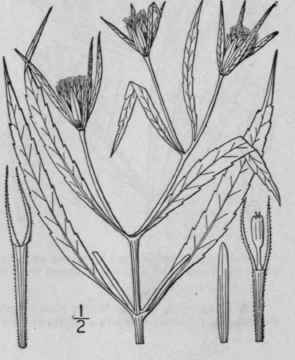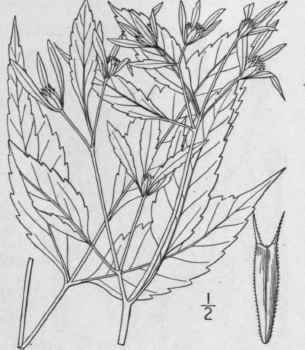71. Bidens L. Sp. Pl. 831. 1753. Part 3
Description
This section is from the book "An Illustrated Flora Of The Northern United States, Canada And The British Possessions Vol3", by Nathaniel Lord Britton, Addison Brown. Also available from Amazon: An Illustrated Flora of the Northern United States, Canada and the British Possessions. 3 Volume Set..
71. Bidens L. Sp. Pl. 831. 1753. Part 3
5. Bidens Bidentoides (Nutt.) Britton. Swamp Beggar-Ticks
Fig. 4509
Diodonta bidentoides Nutt. Trans. Am. Phil. Soc (II) 7: 361. 1841. Coreopsis bidentoides T. & G. Fl. N. A. 2: 339. 1842. B. bidentoides Britton, Bull. Torr. Club 20: 281. 1893.
Closely resembles B. connata, glabrous throughout; stem branched, 1°-4° high. Leaves similar, lanceolate, sharply serrate, petioled, or the upper sessile and entire, acuminate at the apex, nar-nowed at the base; involucre narrowly or becoming somewhat broadly campanulate, its outer bracts linear, foliaceous, not ciliate, usually much exceeding the oblong inner ones; rays none, or rarely present and very short; achenes linear-cuneate, 3"-5" long, their sides and the 2 slender pappus awns (rarely with 2 short intermediate awns) upwardly barbed or hispid.
Muddy shores of the Delaware River and Bay in Pennsylvania, New Jersey, Delaware and Maryland. Aug.-Oct.

GEnus 71.
6. Bidens Discoidea (T. & G.) Britton. Small Beggar-Ticks
Fig. 4510
Coreopsis discoidea T. & G. Fl. N. A. 2: 339. 1842. B. discoidea Britton, Bull. Torr. Club 20: 281. 1893.
Annual, glabrous, slender, branching, erect, 2'-6° high. Leaves membranous, very slender-petioled, all the lower ones divided into 3 lanceolate or oblong-lanceolate, dentate, acuminate segments which are 1-3' long; uppermost leaves commonly rhombic-lanceolate and undivided; heads usually numerous, slender-peduncled, 2"-4" broad and about as high; involucre broadly campanulate or hemispheric, its outer bracts mostly 4, usually foliaceous and obtuse, usually much surpassing the inner ones; rays apparently always wanting; achenes flat, narrowly cuneate, upwardly strigose, about 2" long; pappus of 2 short, upwardly hispid, rarely downwardly barbed awns.
In swamps and wet places, Massachusetts to Virginia, Ohio, Michigan, Louisiana and Texas. July-Sept.


7. Bidens Fronddsa L. Beggar-Ticks. Stick-Tight
Fig. 4511
Bidens frondosa L. Sp. PI. 832. 1753. B. melanocarpa Wiegand, Bull. Torr. Club 26: 405. 1899.
Annual; stem erect, branched, glabrous, or nearly so, often purplish, 2°-3° high. Leaves thin, but not membranous, slender-petioled, pinnately 3-5-divided or the uppermost undivided, the segments lanceolate or oblong-lanceolate, sharply serrate, acuminate at the apex, narrowed at the base, usually slightly pubescent beneath, stalked, 2'-4' long, 1/2'-1' wide; heads usually numerous, long-peduncled, about 6" high, 5"-10" broad; involucre campanulate, becoming hemispheric, its outer bracts 4-8, more or less foliaceous, often much exceeding the ovate-lanceolate, scarious-margined inner ones; rays none or rudimentary and inconspicuous; disk-corollas orange; achenes flat, narrowly cuneate, nearly black, 3"-s" long, ciliate, the two slender awns downwardly barbed, or sometimes upwardly hispid.
In moist soil, often a weed in fields, Nova Scotia to Florida, British Columbia, Texas, Colorado and California. Introduced as a weed into southern Europe. Rayless marigold. Beggar-lice. Devil's-pitchfork. Stick-seed. Common bur-marigold. Old-ladies clothes-pins. Cuckles. July-Oct.
Continue to:


